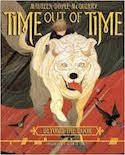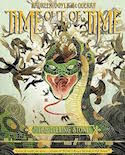
Beyond the Door
Written by Maureen Doyle McQuerry
Amulet Books, 2014, 376 pp.
ISBN: 9781419710162

The Telling Stone
Written by Written by Maureen Doyle McQuerry
Amulet Books, 2015, 353 pp.
ISBN: 9781419714948
Beyond the Door and The Telling Stone are the first two books in the Time Out of Time Series. McQuerry has woven an intriguing and complex fantasy about Timothy, his sister, Sarah, and their friend, Jessica. The three become involved in a quest that propels them from their middle school and high school lives into combat between the Light and the evil powers of the Dark. The characters travel between their world and a parallel one through portals. The actions of all the characters affect people and places in both worlds as they engage in a struggle to save themselves and their worlds in the age-old conflict between good and evil.
These high fantasies makes compelling reading because the adventures involve mythic figures from British, Celtic, and Welsh mythologies who guide and support the children in their quest to overcome evil. McQuerry writes in her entry in the Authors Corner feature on the WOW website, “Students are often exposed to Greek myths in middle school curriculum, but rarely learn about other mythologies. This book became a chance to tell some of those stories.”
McQuerry also explains the inspiration for these books in her Authors Corner feature saying, “The story began with a trip to Oxford, England in 2009 when I discovered ancient carvings of the Greenman, a foliate head with leaves for hair and vines sprouting from his nose and mouth, in many of the churches. As I imagined the process of turning from human to tree, skin splitting to bark, vines pushing up my throat, I scribbled in my notebook. I was hooked. I needed to know more about the origin of Greenmen and more about Celtic mythology, a subject that echoed from childhood stories from my Irish ancestors. The Greenman spans cultures from India to Ireland and appears in medieval poetry. I spent months reading stories of the Wild Hunt, Taliesin and the famous Battle of the Trees.”
The narratives introduce the reader to these mythic creatures and the traditions that enrich the telling. The deliciously evil and beguiling warrior and magician, Balor, is the scary monster that leads the forces of the Dark. Cerridwyn is a Welsh goddess of inspiration and wisdom. Her character is an example of how the mythic creatures in the book take different identities in the parallel worlds. In the children’s world she appears as Timothy’s trusted baby sitter and Jessica’s aunt. In the parallel world she takes different forms, but when the battles occur she is sometimes an archer and sometimes a healer. The Greenman, a pre-Christian symbol that portrays the interdependence of nature and man, provides steady, loving guidance to the children. Herne, the British version of the horned god figure, leads a hunt that pursues Timothy, who by riding Gwydon, a magical wolf, escapes. Gwydon is another mythic character from Welsh mythology.
In her second novel, The Telling Stone, McQuerry gives a comprehensive explanation of the mythic characters. She writes, “I have used legendary names for some of my characters and ignored other traits that did not fit my story. So, while the characters aren’t completely true to their mythology, none are completely foreign to it, either,” (p. 344). McQuerry’s decisions about how she shapes her mythic characters propel the action forward. The only drawback about the Mythic Glossary is that it would have been helpful to have it placed at the end of the first book to illuminate the mythic characters and traditions also featured in that book, Beyond the Door.
Stemming from Irish tradition, Timothy is destined to become a Filidh, an inherited rank that has been passed down in his family. However, no one in his family has been a Filidh for many generations and so Timothy is unaware of his heritage. In Book II, Mr. Twigs, a professor of mythology, tells Timothy that, “A Filidh is a keeper of the word, of memories, tasked with reminding people of the true stories, and in that way the Filidh is a guardian” (p. 82). How Timothy earns the role of Filidh consumes both books.
McQuerry is masterful in her characterizations of the three children. Her ability to ground them in the realities of school, friendships, and their interests makes them believable. For example, Sarah, a ninth grader, is devoted to ballet and wins a scholarship for a two week summer class with the New York Ballet. Seventh grader, Timothy, savors words that specifically describe his situation. He especially enjoys thinking of how each word would win him Scrabble points. He loves researching and learning. The local librarian is his friend and guide who helps him find books, like Chaos Theory, to discover more about his passions. Sarah and Timothy are two years apart and very close siblings. Jessica, an excellent student who wants to hide that fact, is one of the popular girls in seventh grade. In the first part of Beyond the Door she is a bully who torments nerdy Timothy. As the story progresses, Jessica gets pulled into the quest and joins Sarah and Timothy, becoming their friend. One of the most positive aspects of these books is how McQuerry shows the characters’ growth over two years through experiences that require their intelligence, humanity and bravery. The changes Jessica makes are believable and inspiring. Timothy and the girls discover their special gifts through the sacrifices and perils they experience in their battles against the evil creatures of the dark.
Some of the settings in both books are similar. However, in the second book the children travel to Scotland during the Christmas season because Timothy and Sarah’s father is going to speak at a conference on climate change. The children are at first reluctant to travel, but then they learn that Scotland may have clues to advance their quest. The colorful setting of the Edinburgh Christmas German market, the huge Ferris wheel and seasonal displays as well as the famous Edinburgh castle at the center of the city become the focus of solving the puzzles that will give them a way to triumph over the evil forces of Darkness.
To further entice young readers, McQuerry has also included a secret code based on an ancient system of writing, Ogham, developed in Ireland in the fourth century, and provides a key to the code at the end of the Book I. A note to the reader gives background on the ancient language. The author also explains the background about Ogham in her Authors Corner entry. “When I discovered the ancient Ogham writing system based on the tree alphabet, I was fascinated to learn you can still find Ogham carved on stones today in the British Isles. I wanted young readers to share my fascination. Timothy discovers Ogham on an ancient map and readers can experience the discovery as they read. An Ogham font runs along the bottom pages (Book I) and can be decoded, giving more information about the myths.” Book II gives the reader an opportunity to work along with Timothy and the girls as they solve the Ogham code on an ancient map that is a key to making their quest. The second book also contains a map that will help readers understand the action.
The audiences for these books are sixth through tenth graders. The books make terrific read-alouds that engage listeners. Clearly, McQuerry’s background as a teacher makes her aware of how teens talk and engage with each other as well as with contemporary issues. Readers who have enjoyed Rick Riordan’s Percy Jackson and the Olympians series will be eager to discover other mythic powerful figures. The books of Susan Cooper in the Dark is Rising series also feature epic struggles between the Light and Dark. The Wee Free Men series by Terry Pratchett is another series to recommend to young people who enjoy McQuerry’s books.
I am eager for the third book in the series because I have enjoyed the theme that good does overcome evil through sacrifice and pain. The theme of how the ancient stories can be guides to our lives in the 21st century can be inspiring to young readers. With these books, McQuerry takes her rightful place as a writer of high fantasy in the tradition of Ursula Le Guin, Susan Cooper and Phillip Pullman.
Marilyn Carpenter, Professor Emeritus, Eastern Washington University
WOW Review, Volume VII, Issue 3 by Worlds of Words is licensed under a Creative Commons Attribution-NonCommercial-ShareAlike 4.0 International License. Based on work at https://wowlit.org/on-line-publications/review/vii-3/
